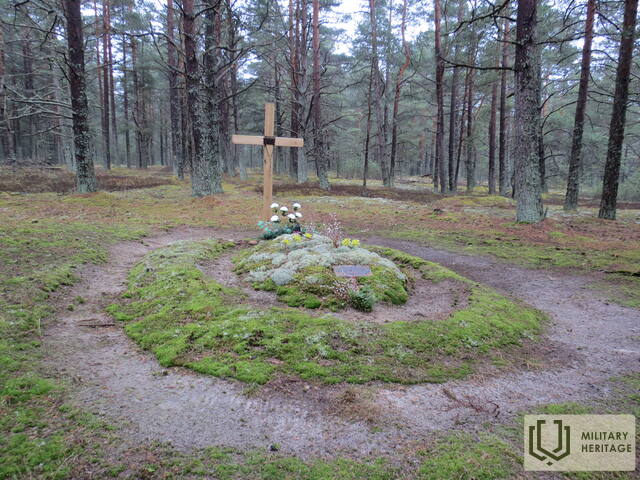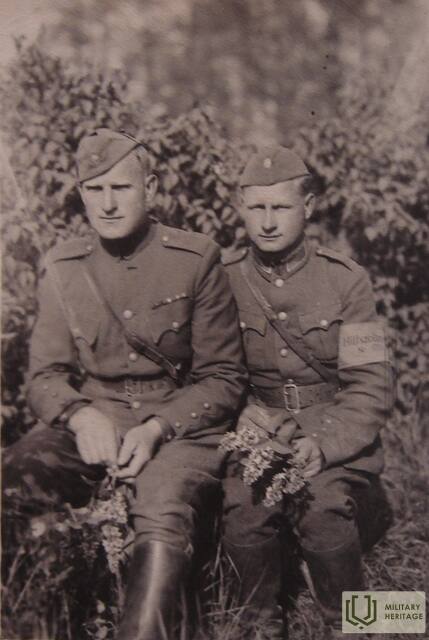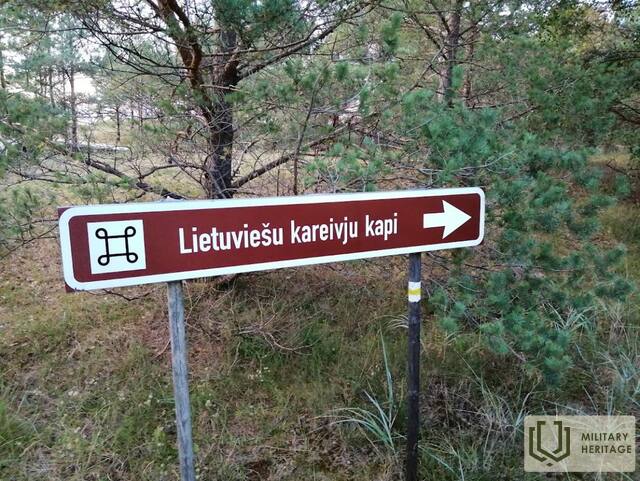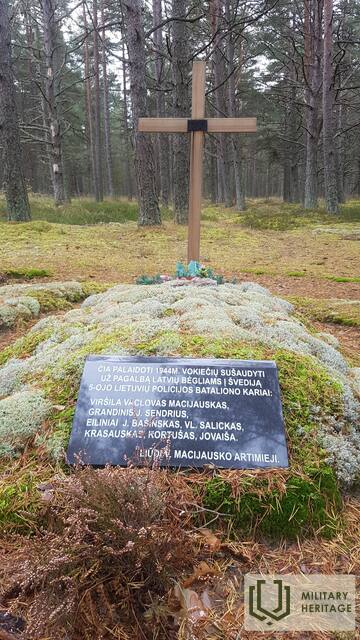Lithuanian soldiers' graves in Zaļkalns Forest
Memorialinis vieta


 215
215






The memorial is located near the Pāvilosta beach lookout tower in the dunes. There are signs pointing to the memorial.
At the end of the Second World War, three Lithuanian police battalions, the 5th, 13th and 256th, were also deployed in Latvia, and after guard duty and fighting against Soviet partisans and the Red Army on the Eastern Front, from autumn 1944 they were involved in guarding the Baltic Sea coast in Kurzeme.
In October 1944, all three battalions, consisting of 32 officers and about 900 instructors and soldiers, were subordinated to the German 18th Army's 583rd Rear Guard Unit (Koruck 583). The unit was tasked with guarding the Kurzeme coast from Liepāja to Ventspils. All three Lithuanian battalions were deployed in the vicinity of Pavilosta. In December 1944, the 13th Battalion was transferred to the German 1st Army Corps at the Liepaja Lake.
One of the tasks of the Lithuanian coastguard, besides being ready to fight enemy landings and to report enemy ships, was to prevent Latvian refugee boats from sailing to the island of Gotland, 160 kilometres away, but the Lithuanian coastguard men did not prevent the refugee boats from leaving. However, news of the Lithuanian coastguard helping the Latvian refugees and the Lithuanians themselves preparing to cross the sea to Sweden also reached the Germans.
On 10 January 1945, the soldiers of the 1st Company of the 5th Lithuanian Police Battalion were rounded up. More than a week of interrogation and trial followed, which, as a warning to the others, decided to execute seven of the Lithuanian soldiers and to imprison 11 of their comrades in concentration camps in Germany. The execution of the seven Lithuanian soldiers (Sergeant Macijauski, the company commander; Juozas Sendrjuas, a soldier; Vladas Salickas, a soldier; Ionas Bašinskis, Krasauskas and two unknown others) took place on 21 January 1945 in the Zaļkalns Pines in Pavilosta.
In January 1945, the 5th Battalion was disbanded and the combat-ready soldiers were divided into the two remaining battalions, while the rest were formed into a separate sapper company. At the time of the surrender of Army Group Kurzeme in May 1945, two battalions (13th and 256th) were still in Kurzeme as a sapper company with a total of 900 soldiers who were taken prisoner by the Soviets.
Panaudoti šaltiniai ir literatūra:
https://www.la.lv/lietuviesu-karaviru-drama-latvija
https://www.lsm.lv/raksts/dzive--stils/cilvekstasti/latvijas-klusie-varoni-lietuviesi-kas-nelika-skerslus-begliem-doties-pari-jurai-uz-gotlandi.a336877/
Susijusi laiko juosta
Susijusios temos
Susijusi istorija
Pirmasis pabėgėlių laivas „Centība“ iš Bambalio
1944 m. spalio 31 d. laivas "Centība" išplaukė iš Kuržemės kranto. Šio laivo išplaukimą pagal kelių bendrakeleivių prisiminimus rekonstravo Latvijos centrinės tarybos sušaukėja Valentīne Lasmane.
Užjaučiantys Lietuvos pakrančių apsaugos vyrai
Prieš daugiau nei 70 metų Lietuvos pakrančių sargybiniams buvo įvykdyta mirties bausmė už tai, kad jie padėjo savo kaimynams, latviams laivų pabėgėliams, pasiekti Švediją. Apie tai sužinojusi okupacinė vokiečių valdžia žiauriai
Vokiečių kariuomenės radiolokacinis postas Jūrkalnėje
Siekdamos apsaugoti Kuržemės pakrantę nuo galimo sovietų ar net Vakarų sąjungininkų puolimo, Vokietijos ginkluotosios pajėgos keliose vietose dislokavo radiolokacines stotis, kurios leido daug anksčiau nustatyti priešo oro veiklą. Vienas jų įrengtas ties Jūrkalne
Pabėgėlių laivelių perkėlimo punktas iš Kuržemės pakrantės į Švediją prie „Pāžu“ namų
Viena iš svarbių persikėlimo vietų buvo prie „Puslapių“ namų, kur dabar stovi paminklas – „Vilties burė“. „Laivai atplaukdavo reguliariai ir daugiausia žmonių išplaukdavo iš „Pažo“, – pasakoja I. Freibergo prisiminimai.







